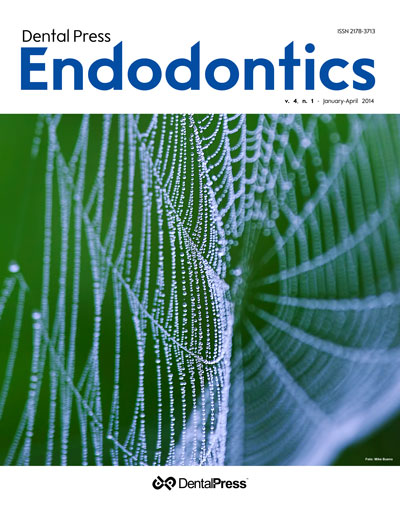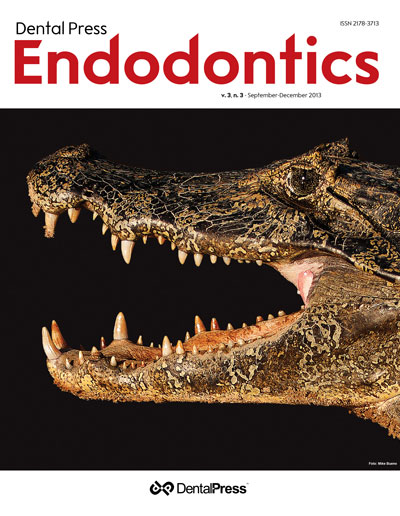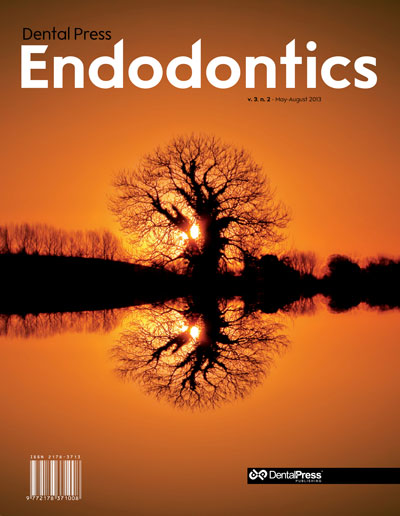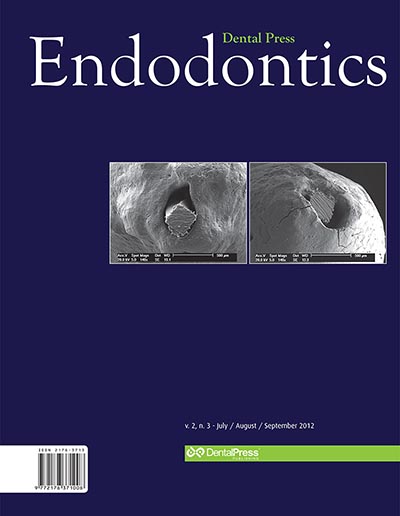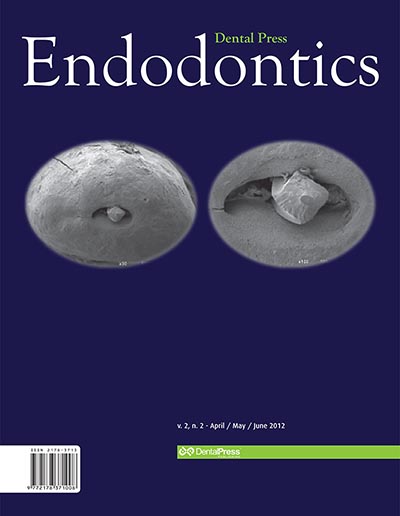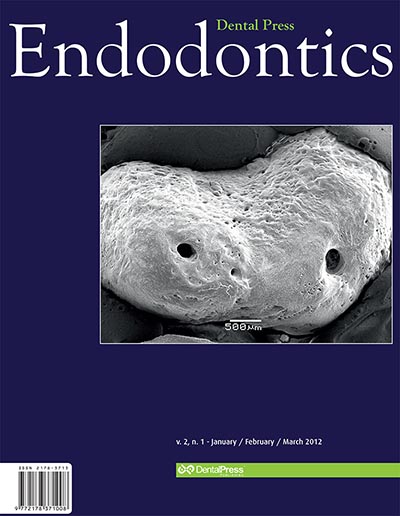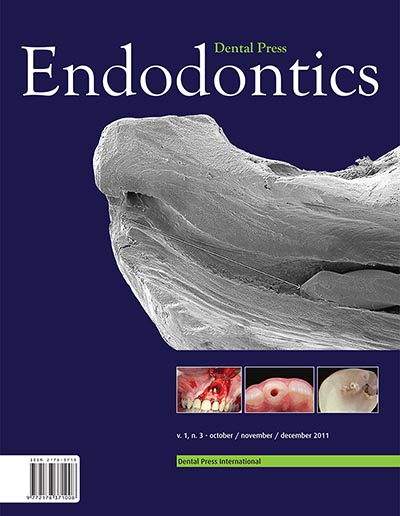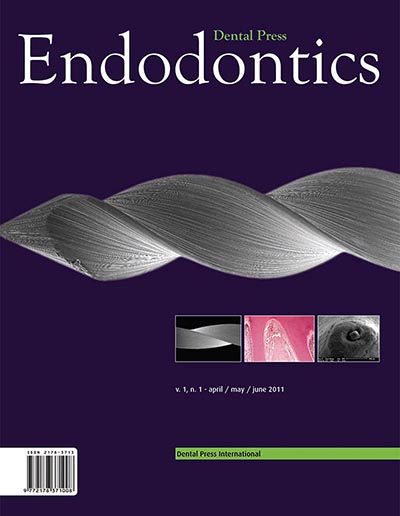v. 03, no. 2
Dental Press Endodontics – ISSN 2178-3713
Dental Press Endod.
v. 03, no. 2
May / August
2013
Editorial
Prospect of endodontic success
003 003
A successful endodontic treatment partially represents a qualitative reward of correctly performed operational procedures.
Endodontic treatment provides innumerable challenges, among which the following may be highlighted: the need for reaching complex inner anatomy, understanding the strategies to control the microbiota of the infected root canal and perceiving treatment outcome on the basis of each individual’s immunologic response. The clinician’s knowledge and psychomotor ability are essential for this process.
When properly used, the new technology available is considered a valuable tool and may influence the quality of endodontic treatment. Some examples include cone beam computed tomography (carried out at different treatment stages) and the use of nickel-titanium rotary instruments during root canal preparation.
Following and valuing the criteria established for each step results in discipline and decreases any potential difficulties. Scientific and technological knowledge as well as psychomotor ability (training), all together, reinforce the need for a professional who is focused and always eager to acquire excellence in endodontic treatment.
Carlos Estrela
Editor-in-chief
Endo in Endo
Foraminal debridement: reflections and insight
Instrumentation. Rotary instruments. Apical repair. Periapical repair.
012 015
One of the procedures employed for canal treatment during endodontic therapy, be it performed by manual technique or with rotary instruments, is the foraminal debridement, in which the first tool is used beyond the foraminal opening (0.5 to 1 mm). Some reflections on the clinical implications of these procedures include the real dimension of periodontal ligament thickness and its inflammatory and connective tissue reactive characteristics. These reflections and an insight for future studies are presented here.
Original articles
Evaluation of silver nanoparticles as irrigating solution
Endodontics. Biocompatibility. Connective tissue biology.
016 023
Introduction: Irrigation is an important procedure during root canal treatment once it can help cleaning those areas of the root canal system not directly reached by instruments.
Objective: The aim of this study was to evaluate the biocompatibility and disinfection ability of silver nanoparticles dispersion in comparison to 2.5% sodium hypochlorite.
Methods: Thirty two rats individually received 4 infected and uninfected dentin tubes irrigated with 47 ppm and 23 ppm silver nanoparticles dispersion, 2.5% sodium hypochlorite, and saline solution. Sixteen rats received one infected and one uninfected dentin tube, as the control group. After 7 and 30 days, all the animals were killed, the tubes and surrounding tissues were removed, and prepared to be analyzed in light microscope. Qualitative and quantitative assessments of the reactions were carried out.
Results: All solutions in uninfected tubes caused mild reactions after 30 days. All solutions in infected tubes caused severe reactions after 7 days and mild reactions after 30 days. The outcomes were similar to those of the uninfected control group, but better than those of the infected control group.
Conclusions: It was possible to conclude that silver nanoparticles dispersion was biocompatible and may act as disinfectant in contaminated tubes, especially at 23 ppm.
Can the sodium hypochlorite tissue dissolution ability during endodontic treatment really be trusted? An in vitro and ex vivo study
Sodium hypochlorite. Dissolution. Anatomy.
024 029
Objective: The aim of this study was to (1) evaluate the tissue dissolution effect of sodium hypochlorite (NaOCl) at different concentrations on the apical portion of mesial root of human mandibular molars with isthmuses; and (2) evaluate the dissolution time of bovine pulp tissue in direct contact at different concentrations and volumes of NaOCl.
Methods: Histologic investigation was performed in thirty mesial roots of human mandibular molars that were instrumented using the Mtwo system and irrigated with 2.5% NaOCl or 5.25% NaOCl. Saline solution was used as control. Each sample was submitted to histologic processing and the images were analyzed using the ImageJ software. The percentage of area occupied by tissue was calculated by dividing the area of tissue by the canals area. Data were analyzed by means of the analysis of variance with Tukey test (P < 0.05). Dissolution time was analyzed by immersing bovine pulp tissue in different volumes of 2.5% and 5.25% NaOCl solution.
Results: No significant difference was found between the NaOCl concentrations in the histological investigation. No substance was able to completely clean the isthmuses. Moreover, a higher dissolution rate for the bovine pulp tissue was found in NaOCl with a concentration of 5.25%, in addition to a shorter dissolution time for larger volumes.
Conclusion: The NaOCl is effective for tissue dissolution when in direct contact, however, NaOCl solution, even in high concentrations, was not competent to dissolve remnants of pulp tissue in root isthmuses during endodontic treatment.
Quantitative assessment of the presence of calcium hydroxide remnants associated with different vehicles after removal of intracanal medication
Endodontics. Calcium hydroxide. Residue removal.
030 034
Objective: The aim of this study was to assess, after removal, the presence of calcium hydroxide (CH) remnants associated with different vehicles in the cervical, medial and apical thirds.
Methods: Forty-five bovine incisors were transversely sectioned at 18 mm from the apex. The canals were biomechanically prepared and received CH. The samples were divided into groups (n = 10): G1, saline solution; G2, CH (BP); G3, polyethylene glycol; G4, polyethylene glycol + CMPC; Negative control, no CH (n = 5). After 7 days, the medication was removed by means of mechanical action of files associated with saline solution irrigation, until the irrigating solution became transparent. The roots were longitudinally sectioned in half. Afterwards, they were photographed and the images were digitalized, allowing the calcium hydroxide remnants to be macroscopically quantified by the Image Tool® software.
Results: The statistic results reveal that all roots presented remnants from the medication within the canals. Saline solution presented a lower amount of remnants, however, it showed a higher concentration in the apical third.
Evaluation of the preparation of root canals with two different systems using micro-computed tomography
Dental instruments. Root canal preparation.
035 040
Introduction: Root canals with long oval cross section make it difficult for rotating tools, which can not be adapted to the walls in its entire extension. The Reciproc single-file system (VDW, Munich, Germany) was developed for the root canal preparation by the reciprocal motion technique. The reciprocal motion relieves the instrument stress, reducing the risk of cyclical fatigue, caused by the tension and compression.
Objective: The objective of this study was to evaluate, ex vivoi>, the long oval root canals preparation of lower molars with Reciproc system, comparing it to the preparation with complete rotating tools, BioRaCe, by means of micro-computed tomography.
Methods: The distal roots of thirty lower molars were used and randomly divided in two groups: G1, Reciproc R40; and G2, BioRaCe. Teeth were scanned by a SkyScan 1172, before and after the root canals preparation. The images obtained were imported, reconstructed and, then, analyzed for comparison of changing in the volume of root canal.
Results: The results were subjected to Mann-Whitney non-parametric statistical test, for the volume analysis. The root canal preparation resulted in increased volume, with significant difference between groups (p < 0.5).
Conclusion: The Reciproc system removed more dentin from the walls than the BioRaCe one.
Evaluation of the effectiveness of the use of photodynamic therapy (PDT) after cleaning and shaping the root canal: An in vivo study
Laser therapy. Enterococcus faecalis. Root canal therapy.
041 045
Objective: The purpose of this study was to assess the effectiveness of photodynamic therapy (PDT) in teeth with periapical lesion seen radiographically.
Methods: 24 anterior teeth were selected and divided into two groups with 12 teeth each. Three samples were collected in each specimen. In G1, endodontic treatment was performed with a nickel/titanium rotary system, with the first sample being collected at surgical opening; the second, after endodontic treatment; and the third, seven (07) days after canal preparation. In G2, the samples were collected by means of the same procedures used in G1, except for the second sample which was taken after instrumentation and photodynamic therapy (PDT). The third sample was collected seven days (07) after PDT. Sodium hypochlorite at 5.25% was used as irrigating solution, neutralized with 5% sodium thiosulfate at a given time of the study. Photon Laser III was used for 40 seconds, with 0.005% methylene blue dye as photosensitive substance. All samples from both groups were send to laboratory analysis to have potential contamination of the root canal system checked.
Conclusion: The results revealed no statistically significant difference between groups, but further randomized studies are necessary to demonstrate the effectiveness of PDT.
Stem cells: A breakthrough in Dentistry
Stem cells. Tissue engineering. Rehabilitation.
046 051
Introduction: Scientific advances made to understand the molecular regulation of tooth morphogenesis, biology of stem cells and biotechnology provide opportunities that will enable tooth regeneration in the near future. Stem cells are capable of stimulating tissue regeneration and, as a consequence, present many therapeutic perspectives, which make them feasible to be applied in Dentistry. Their applicability in the regeneration of oral structures becomes nearer and nearer every day; however, additional studies are warranted to further comprehend the best method for storing stem cells and the adequate laboratorial procedures that shall be applied when those cells are used. Furthermore, it is necessary to know all cell subdivisions, according to their place of origin.
Methods: The method employed for conducting the present study was the search for scientific articles in journals, books as well as in the following databases: BIREME, LILACS, PubMed and SciELO.
Conclusion: This literature review aimed at exemplifying the main groups of cells, their functions and difficulties in order to provide basic knowledge that may be used by dental surgeons.
Photodynamic therapy in Endodontics: Use of a supporting strategy to deal with endodontic infection
Endodontics. Endodontic infection. Photodynamic therapy.
052 058
Endodontic treatment is of paramount importance to abolish infection in teeth with pulp necrosis. The success of this type of treatment depends on efficient elimination of infection in the root canal system (RCS) and correct sealing carried out with root canal filling materials. Due to the anatomical complexity of the RCS, certain areas may be inaccessible to biomechanical preparation (BMP), therefore, the use of intracanal medication enhances the reduction in microorganisms (MO) and their toxic products inside the RCS. MO can still survive even with the scientific and technical adventancement of endodontic therapy, being primarily responsible for maintaining endodontic infection. Thus, new treatmenttments should be investigated. Alternative treatments have emerged in the health field with the advent of laser and LED devices, such as photodynamic therapy (PDT), which is a set of physical, chemical and biological procedures that occur after the administration of a photosensitizing agent (PS) activated by visible light of a specific wavelength (laser or LED) to destroy the target cell or assist infection combat. In Endodontics, based on in vitro and in vivo studies, the use of PDT has proved to act as an adjunct, enhancing the disinfection of the RCS, besides being easy to be applied and not promoting microbial resistance. The aim of this review is to present the current status of photodynamic therapy in Endodontics.
Diagnosis of vertical root fractures in endodontically prepared teeth, with or without the presence of intracanal cast metallic posts using Cone Beam Computed Tomography
Image diagnosis. Endodontics. Spiral cone beam computed tomography.
059 063
Objective: To assess the diagnosis of vertical root fracture in teeth endodontically treated, with or without cast metal post (CMP), by means of CBCT, using Prexion Scanner.
Methods: The sample consisted of 48 human premolars extracted, single-rooted, which were divided in 3 groups: Group 1, control, 16 teeth without gutta-percha and CMP, from which 8 were artificially fractured; Group 2, 16 teeth presenting gutta-percha, from which 8 were artificially fractured; Group 3, 16 teeth presenting CMP, from which 8 were artificially fractured. The teeth were fractured according to the method set out in literature. A specialist in dental radiology, with 10 years of experience in tomography, evaluated the scans. Sensibility, specificity and accuracy were calculated by means of a dichotomous evaluation (presence or absence of fracture).
Results: By means of Fisher’s test, it was not detected statistical difference between groups regarding accuracy, sensibility and specificity for the fracture diagnosis, yet there was a high percentage of false positive for the Group 3.
Conclusion: CBCT is an excellent tool for the vertical fracture diagnosis; however, the CMP presence generates images with many artifacts, resulting in a high percentage of false positive, being of paramount importance to join the tomographic findings to the signs and clinical symptoms for the most possible accurate diagnosis of fracture.
Accidents and complications in Endodontics caused by sodium hypochlorite: literature review
Sodium hypochlorite. Accident. Irrigant. Endodontics.
064 069
This review shows the accidents and complications that can be caused by inappropriate use of sodium hypochlorite (NaOCl) during the endodontic treatment. This solution has been used since 1920 in concentrations of 0.5% to 5.25% as an antimicrobial irrigant to assist the mechanical preparation of root canals, it is clinically proven to be a lubricant, antiseptic and solvent of body tissue. However, serious accidents, such as skin and intraoral mucosa burns, laryngeal edema, upper airway obstruction, paresthesia, bleeding and others, may occur when used inadvertently. Thus, careful technique, storage and handling must be taken, in order to prevent these undesirable complications. Furthermore, the professional must be able to identify and solve problems when it occurs.
Odontogenic cutaneous sinus tract: Case report
Cutaneous sinus tract. Diagnostic services. Endodontics.
070 074
Introduction: Odontogenic sinus tracts are canals originated from dental inflammation and which drain into the orofacial and neck region. One of the most common causes of odontogenic sinus tract formation is the presence of cavities or dental trauma, with bacterial invasion in the pulp tissue and subsequent pulp necrosis.
Objective: To report the clinical history of a patient who attended the UESB College of Dentistry presenting an odontogenic cutaneous sinus tract.
Case report: A 47-year-old woman presented herself to the service of endodontics of UESB College of Dentistry complaining of an extra-oral sinus tract on the left side of her face. After appointments with otolaryngologists, ophthalmologists and other physicians, the patient sought dental care. Periapical radiographs revealed carious lesions in the left lateral incisor, with the presence of periapical pathology. Endodontic treatment was proposed and performed in a single session.
Results: Three days later, the sinus tract had regressed and there was only a scar on the site, due to tissue retraction for closing the opening hole of the lesion. Two months later, a radiographic examination showed bone formation in the apical region of the tooth and no pathology.
Conclusion: Knowing this condition proves to be of paramount importance for dentists and physicians to correctly conduct the diagnosis and treatment of the disease.
The importance of the use of computed tomography in diagnosis and in endodontic planning: a case report
Cone-beam computed tomography. Periapical periodontitis. Endodontics.
075 079
Objective: The aim of this study was to report a case of an endodontic re-treatment in a patient submitted to orthognathic surgery, using computed tomography to aid the diagnosis and treatment plan.
Methods: The patient was referred for endodontic evaluation of anterior teeth with a history of orthognathic surgery on the maxilla and rigid internal fixation with miniplates for osteosynthesis in the region close to the dental apexes.
Results: A three-dimensional evaluation of the region demonstrated periapical lesion of the left central incisor. The endodontic re-treatment resulted in remission of symptoms and regression of periapical bone rarefaction.
Conclusion: The use of computed tomography was essential to the resolution of this case, what was proved with bone neoformation.
Maxillary sinus disease of odontogenic origin
Maxillary sinus. Dental infection. Oral diagnosis. Maxillary sinusitis.
080 083
Introduction: Due to the intimate relationship between the root apices of maxillary posterior teeth and the maxillary sinus, in some cases, maxillary sinusitis may be of odontogenic origin, such as tooth extractions, periodontal and periapical lesions (abscesses, granulomas and root cysts). Computerized tomography is the exam of choice to help with the diagnosis of sinusopathies.
Objective: The aim of this study was to assess the aspects that characterize an odontogenic sinusitis by means of a case report.
Apexification without periodic changes of intracanal medicament and mta apical plug: 5-year follow-up
Endodontics. Necrotic dental pulp. Tooth root.
084 089
Objective: The objective of this report was to present a case of apexification in traumatized teeth treated with two different therapies for immature teeth.
Methods: An 11-year-old male patient was referred to the Dental Trauma Service of the College of Dentistry — Piracicaba (UNICAMP), with enamel dentin fracture in the maxillary central incisors associated with subluxation caused by a bicycle fall 3 years before. The radiographic examination revealed immature teeth. After necrotic pulp had been diagnosed, the treatment plan comprised apexification with intracanal medicament at the right central incisor and MTA apical plug in the left central incisor. The intracanal medicament protocol was performed with an obturation paste composed of calcium hydroxide, 2% chlorhexidine gel and zinc oxide without periodic changes. The MTA plug sealed the apical third of the root canal while the middle and cervical thirds were sealed with coltosol.
Results: After an 8-month follow-up, apical closure of both teeth could be observed, without dissolution of intracanal dressing. After a 5-year follow-up, the teeth did not present symptomatology and the periapical lesions were repaired.
Conclusion: Based on the results of this study it is reasonable to conclude that both apexification therapies may be concluded within a few sessions and may provide clinical success and comfort to the patient.
CBCT-guided endodontic management of maxillary central incisor fused to mesiodens: a case report
Cone-beam computed tomography. Image diagnosis. Fusion. Supernumerary teeth. Endodontics
090 095
Objective: The aim of this case report is to present a predictable and successful solution toward the endodontic and esthetic management of a maxillary central incisor fused to a mesiodens, adopting a conservative and multidisciplinary approach.
Results: In the present case, cone-beam computed tomography (CBCT) was helpful for endodontic diagnosis and a better understanding of the complex root canal morphology of the fused teeth.
The use of MTA in the treatment of cervical root perforation: case report
Root perforation. MTA. Calcium hydroxide.
096 101
Objective: The aim of this study was to report the treatment of a tooth with cervical root perforation caused during endodontic treatment.
Methods: The patient attended the endodontist’s office with painful symptoms resulting from a cervical root perforation exposed to the oral cavity. The endodontic treatment was performed in multiple sessions using the dressing with calcium hydroxide and propylene glycol, in order to aid the decontamination of the root canal and the perforation. The root perforation was sealed with MTA because this material is capable of forming mineralized tissue due to its sealing ability, biocompatibility and alkalinity. In addition, the humidity present in the periodontal tissues can provide the necessary means to adapt the MTA on the walls of the perforation and its setting expansion, justifying its use in this case as it is a case of cervical perforation, a difficult site to control humidity.
Conclusion: The authors concluded that MTA is an excellent material for sealing cervical root perforation.


